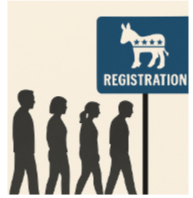How the GOP transformed its tariff messaging from an economic liability into a case study in political strategy.
What to Know:
- The Republican Party shifted its message from “Tariffs make us rich” to “Tariffs as leverage”.
- Real trade deals with China and the UK boosted voter confidence in the policy
- Democrats failed to present a consistent alternative, losing support in key regions
- National security framing helped Republicans connect tariffs to fentanyl, IP theft, and China
- Tariffs are now a foundational part of the GOP’s broader economic and manufacturing strategy
The GOP's trade rhetoric has quietly but crucially evolved. Donald Trump's provocative assertion, "Tariffs make us rich," has been reframed into a more strategic, results-oriented argument: tariffs as leverage. Real-world trade deals and consistent messaging discipline were key to this shift, enabling Republicans to regain support and firmly establish economic nationalism as a central tenet of their brand, even among skeptical swing voters.
The following analysis is based on multi-week EyesOver AI sentiment tracking, compiled by Campaign Now’s research team as the foundation for this report.
The Problem With “Tariffs Make Us Rich”
Trump’s early messaging was simple and bold. But outside his base, it fell flat. Voters experiencing inflation and price shocks saw tariffs not as patriotic protectionism but as higher costs at checkout.1 Democrats hammered this framing, calling it chaotic and inflationary. Their critiques connected tariffs to market volatility and the security of retirement savings, resonating particularly with older demographics and voters primarily concerned with economic issues.2
Internal GOP polling showed House Republicans trailing Democrats by 1% in tariff sentiment, a rare dip.3 Even Republican Senators like Rand Paul and Mark Kelly, who criticized tariffs, lost favor with GOP voters4 Paul’s anti-tariff bill tanked his support among the MAGA base.
The Pivot From Blunt Slogans to Strategic Tools
By mid-April, the narrative pivoted. Tariffs were no longer promoted as a means of wealth generation but rather as a tool for negotiation. The new frame emphasized “control over chaos,” positioning Trump as an active enforcer confronting China and reasserting U.S. power.5
This approach was effective. When tariffs were associated with tangible outcomes like job reshoring, improved trade agreements, and compelling concessions from international rivals, voter approval increased. Key figures like Treasury Secretary Scott Bessent (44%) and Commerce Secretary Howard Lutnick (40%) held steady in approval even amid fierce attacks.6
Proof and Victory from Trade Deals
The trade agreements with the United Kingdom and China marked a turning point in the Republican message on tariffs. For months, the idea of using tariffs as a strategic tool had been central to GOP rhetoric, but it lacked clear validation. These two agreements provided it. According to EyesOver sentiment data, public confidence in the Republican trade strategy increased following the announcements.7
In key manufacturing regions like the Midwest, particularly across the Rust Belt, the impact was noticeable. Sentiment around Trump’s trade policy stabilized as the administration highlighted new industrial investments and job commitments tied to the deals. Voters in these areas responded more to visible economic outcomes than abstract policy arguments.
Republicans also expanded their message by connecting trade policy to national security concerns. By tying China to issues such as fentanyl trafficking, intellectual property theft, and foreign influence operations, they framed tariffs as part of a broader effort to protect American interests. This message drove a 65% positive sentiment rating among voters surveyed.8
Together, these developments allowed Republicans to shift the conversation. Instead of defending tariffs as a general economic principle, they pointed to recent trade outcomes as practical examples of successful negotiation. For many voters, particularly those concerned about job loss and global competition, this reframing made the policy more credible and the results more tangible.
Democratic Messaging Fell Apart
While Republicans were consolidating their message, Democrats struggled to maintain a clear position on trade. Initially, Democratic leaders broadly opposed the use of tariffs. Later, their position shifted, with some calling for more targeted use of trade measures and others accusing the Trump administration of conceding too much in negotiations with China.9 These conflicting narratives created confusion among voters and weakened the party’s message.
Efforts to frame trade policy through legal arguments or procedural critiques did not resonate with the public. Messaging that emphasized concepts like market stability or rule-of-law enforcement often failed to address the economic concerns most voters prioritized. The same issue appeared in adjacent policy areas, such as immigration, where appeals to due process were seen as less urgent than security or economic stability.10
In several Latino-majority districts, Democratic messaging on border security and deportation policies failed to gain traction. Sentiment in these regions remained low, with only 26.5% expressing support for the party’s position.11 Representative Eric Swalwell's public criticism of the China trade agreement led to a decline in his support, indicating that his stance on the deal was not in line with the prevailing voter sentiment. The result was a fragmented communication strategy that lacked consistency across regions and issues, making it harder for Democratic candidates to present a unified alternative.
Before and After: Why Framing Mattered
The updated framing, “Tariffs as leverage,” took a strategic approach. Rather than portraying tariffs as an end goal, Republicans began presenting them as a tool for securing stronger trade agreements and protecting American jobs. This version of the message was tied to specific outcomes, including agreements with the United Kingdom and China, job creation, and national security. It made the policy feel targeted and results-driven. Voters responded more positively, especially in key manufacturing states.
Image generated by DALL-E
This shift in language helped Republicans maintain support from their base while reconnecting with independent voters. It moved the conversation away from abstract slogans and toward practical impact. The change made the policy easier to defend and gave the party a clear message grounded in real-world developments.
What’s Next for GOP Messaging
To maintain their advantage on trade, Republican strategists will need to keep building on the recent shift in framing. One priority is to place tariffs within a broader economic relief agenda. Rather than presenting them in isolation, the message should connect tariffs to policies that directly benefit working families, such as adjustments to Social Security taxes and increases in take-home pay.12 This approach links trade to everyday financial concerns that matter to voters.
It is also important to reinforce the theme of keeping promises. Republican messaging should consistently point to fulfilled commitments like new job creation, tougher border enforcement, and rebalanced trade agreements.13 These examples make the case that voters are seeing real action, not just campaign talking points.
The emphasis on results should continue to guide all communications. Republicans are most effective when they focus on delivery, not debate.14 Trump’s team has gained traction by framing him as the candidate who enforces outcomes, especially when compared to what many see as delays and inconsistencies from Democratic leaders.
Foreign policy achievements should be positioned not as acts of isolation but as evidence of strong leadership. Trade agreements, diplomatic breakthroughs, and strategic concessions from adversaries can all serve to reinforce the idea that Republican policies are producing gains on the world stage.
Finally, the party should keep its focus on manufacturing. The image of a reopened factory remains one of the most powerful visuals for voters who feel left behind by global trade. Tangible examples of production returning to American soil can drive positive sentiment and reinforce the overall economic message.
Wrap Up
The Republican Party did not abandon tariffs. Instead, it refined how they were presented. What once sounded like an economic slogan was transformed into a strategy supported by trade deals, job growth, and national security priorities. By reframing tariffs as leverage rather than reward, Republicans moved from abstract promises to practical outcomes.
This shift helped unify the base and brought skeptical voters back into the fold. The message became less about ideology and more about delivery. Republican leaders showed they could adapt their language while staying true to their broader goals.
Meanwhile, Democrats struggled to present a clear alternative. Their position on trade shifted too often and lacked a unifying story. Without a consistent explanation or a clear response to voter concerns, their critiques failed to stick.
Ultimately, Republicans secured the advantage not only through policy adjustments but by sharpening their messaging. They converted a potential political weakness into a defining strength, leveraging consistent repetition, strategic timing, and visible evidence that resonated with voters.
Sources:
1. EyesOver, May 2025 Snapshot, pp. 94, 111, 128.EyesOver, April 2025 Snapshots, pp. 23, 34, 45, 63.
EyesOver, April 10 Snapshot, p. 22.
EyesOver, April 10 and May 7 Snapshots, pp. 18, 91.
EyesOver, April 16 and 23 Snapshots, pp. 46, 64.
EyesOver, April 16 and 23 Snapshots, pp. 30, 55.
EyesOver, May 14 and 22 Snapshots, pp. 100, 108, 127, 130.
EyesOver, April 23 Snapshot, p. 53.
EyesOver, May 14 Snapshot, p. 109.
EyesOver, April 23 and 30 Snapshots, pp. 61, 77.
EyesOver, April 30 Snapshot, pp. 68, 73, 77.
EyesOver, April–May Snapshots, pp. 23, 33, 44, 93, 110.
EyesOver, April 10–23 Snapshots, pp. 24, 35, 46, 64.
EyesOver, April 30–May 22 Snapshots, pp. 81, 95, 112, 129.

.png)



.png)